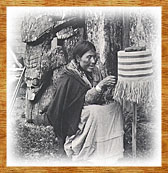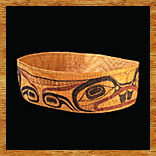 Boxes and Boxes and
 Chests Chests
 Basketry Basketry
 |
Basketry
Haida women made a range of baskets from large coarsely woven ones that would allow clams to drain, to drinking cups so tightly woven they would hold water. Every woman had her work baskets, which were usually hung from the walls or rafters of the house. Other baskets were made for the storage of clothes, as well as roots and vegetables. Cooking baskets of red cedar bark with an open weave were used to boil berries, prior to mashing and drying them for winter use. Woven strainers were used to skim off the grease when boilding black cod. Potato baskets became a common item when, as part of the nineteenth-century economy, the Haida grew potatoes to sell to mainland natives and maritime traders.

 |
A woman from Masset weaving a basket on a stand, 1897. Such baskets provided women with an important source of income in the early tourist economy.
© The Field Museum, Neg. CSA854
Photographer: Edward P. Allen
|

Containers were also woven for a great many other specific functions such as burden baskets, bait baskets, basket quivers for arrows and even stout baskets for anchor stones. Cradles were also fashioned of basketry, although wooden ones were more popular. Fancy baskets for storing soapberry spoons became something of a specialty, as did drinking cups, and very fine examples were woven for domestic use as well as for trade.
Women also wove many types of basketry mats for household use. Meals were eaten on them, babies were born on them, people slept on them and the dead were wrapped in them for burial. Old mats were recycled as covers for boxes or for covering canoes to keep them from checking in the sunlight. Designs on mats were geometric but could be quite complex. Some patterns had individual names and meanings, and specific designs belonged as a privilege to certain families of high rank. These design motifs have not been thoroughly analysed, but in his unpublished notes, Charles F. Newcombe documented the names of many of them, such as "slug trail," "comb pattern," "shadow," "small waves in calm waters," "the crossing of the sticks of a drying frame for fish," "little breeze on the water" and so on. Museum collections contain numerous painted mats, some of which may be attributed to the Haida, but many appear to be intended for the early tourist trade and there is no evidence they were ever produced in Haida country.
Although the art of weaving hats, mats and baskets almost disappeared from the 1930s until the late 1950s, the recent renaissance of feasting has encouraged young women to learn basketry from their grandmothers. Dorothy Grant from Hydaburg, Alaska, typifies the younger generation who have mastered this skill, and she has produced a wide range of hats and baskets. The Haida artist Robert Davidson has painted crest designs on many pieces of her work, including hats. These new examples are as fine as any old examples and are sought after by museums in America and Japan.

 |
Shallow trays of tightly woven spruce root, such as this one with a Beaver crest, were suitable for display in a Victorian home. This one was created by Isabella and Charles Edenshaw for sale to travellers, although it is totally traditional in style and manufacture.
Collected at Masset in 1898 by Charles F. Newcombe.
CMC VII-B-1135 (S94-6777) |

|